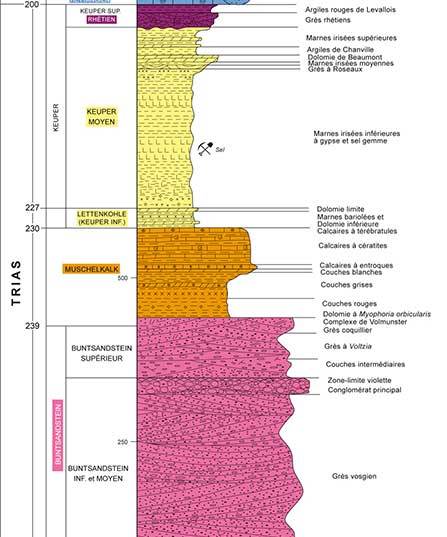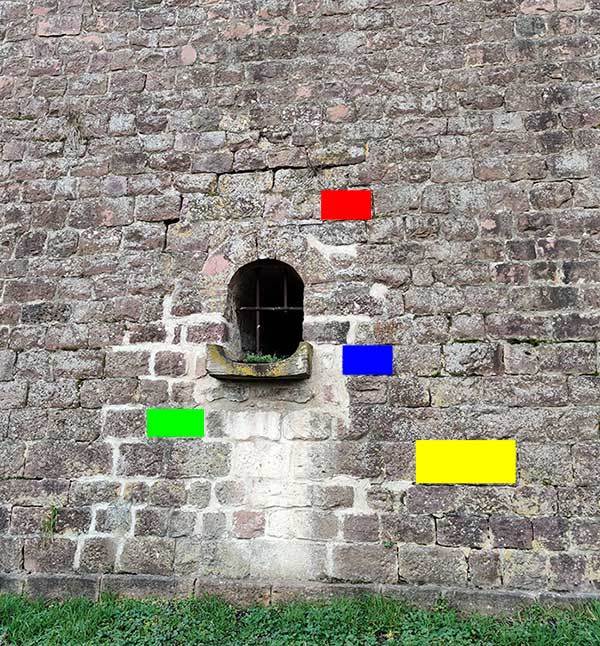[GBE20] Grès conglomératique EarthCache
[GBE20] Grès conglomératique
-
Difficulty:
-

-
Terrain:
-

Size:  (other)
(other)
Please note Use of geocaching.com services is subject to the terms and conditions
in our disclaimer.
Le grès conglomératique FR
Le grès affleure sur de grandes surfaces où ils participent à la structuration du paysage.
Le grès rose connu aussi sous le nom allemand de « buntsandstein » est une roche caractéristique des Vosges et de l’Alsace.
Le sable à l’origine de ce grès provient de l’érosion des derniers reliefs de la chaine Hercynienne au début du Trias, il y a 250 millions d’années.
Formation du grès:
Lors de l'érosion des reliefs les rivières vont transporter du sable et des galets (produits de l'érosion) dans les plaines Vosgienne et Alsaciennes. Tous ces sables et galets vont être ensuite enfouis et recouvert par d'autres dépôts sédimentaires. Sous l’effet de la pression et de la chaleur, le phénomène de diagenèse a lieu, sables et galets vont peu à peu se compacter et se silicifier ensemble et créer le grès.

Comme vous pouvez le voir sur le schéma ci-dessus, le grès vosgien est surplombé par une couche d'environ 15m de grès conglomératique.
La différence entre ces deux couches est sa composition:
- Le grès vosgien est constitué de grain très fin faisant moins de 2mm et est très uniforme.
- La couche de conglomérat principal quant a elle est composé de morceaux discernables (c'est à dire qu'ils doivent mesurer plus de 2mm et qui peuvent faire quelques centimètres) liés entre eux par un ciment naturel.
Parmi les conglomérats, on trouve:
- les brèches, composées de blocs anguleux.
- les poudingues, composés de galets aux formes arrondies.
- les tilites, contenant des cailloux anguleux ainsi que des galets arrondis.
QUESTIONS:

Question 1: A quel période du Buntsandstein est apparu le conglomérat principal ?
Question 2: Sous quel rectangle de couleur (sur la photo ci-dessous) pouvez vous observer du grès conglomératique ?
Question 3: Quel type de conglomérat pouvez vous observer ?
Loguez cette cache "Found it" et envoyez-moi vos propositions de réponses aux questions ci-dessus soit via mon profil, soit via la messagerie geocaching.com (Message Center), et je vous contacterai en cas de problème."
[GBE] Konglomerat-SandsteinDE
Sandsteinaufschlüsse über große Gebiete, wo sie an der Strukturierung der Landschaft beteiligt sind.
Rosa Sandstein, in Deutschland auch als "Buntsandstein" bekannt, ist ein charakteristisches Gestein der Vogesen und des Elsass.
Der Sand am Ursprung dieses Sandsteins stammt aus der Erosion der letzten Reliefs der Herkynischen Kette zu Beginn der Trias-Periode vor 250 Millionen Jahren.
Sandstein Bildung:
Während der Erosion der Reliefs werden die Flüsse Sand und Kieselsteine (Erosionsprodukte) in die Vogesen und die elsässische Ebene transportieren. All diese Sande und Kieselsteine werden dann begraben und von anderen Sedimentablagerungen bedeckt. Unter der Einwirkung von Druck und Wärme findet das Phänomen der Diagenese statt, Sande und Kieselsteine verdichten und verkieseln allmählich miteinander und bilden Sandstein.

Wie Sie auf dem obigen Diagramm sehen können, wird der Vogesensandstein von einer etwa 15 m langen Schicht aus Konglomeratsandstein überragt.
Der Unterschied zwischen diesen beiden Schichten liegt in ihrer Zusammensetzung:
- Der Vogesen-Sandstein wird aus sehr feinen Körnern von weniger als 2 mm hergestellt und ist sehr gleichmäßig.
- Die Hauptkonglomeratschicht besteht aus erkennbaren Stücken (d.h. sie müssen mehr als 2 mm messen und können einige Zentimeter lang sein), die durch einen natürlichen Zement miteinander verbunden sind.
Bei Konglomeraten findet man :
- Brekzien, die aus eckigen Blöcken bestehen.
- Pulverisierte Kieselsteine, die aus runden Kieseln bestehen.
- Tiliten, die sowohl eckige als auch runde Kieselsteine enthalten.
FRAGEN:

Frage 1: In welchem Zeitraum der Buntsandsteinzeit ist das Hauptkonglomerat entstanden?
Frage 2: Unter welchem farbigen Rechteck (im Bild unten) kann man Konglomeratsandstein sehen?
Frage 3: Welche Art von Konglomerat können Sie beobachten?
Loggen Sie sich diesen Cache als "Foundit" ein und senden Sie mir Ihre Antwortvorschläge zu den oben genannten Fragen entweder über mein Profil oder über geocaching.com (Message Center), und ich werde Sie kontaktieren, wenn es ein Problem gibt".
[GBE 20] Conglomerate sandstone EN
Sandstones cover large areas where they participate in the restructuring of the landscape.
Pink sandstone is a characteristic rock of the Vosges and Alsace.
The sand at the origin of these ponds comes from the erosion of the last reliefs of the Hercynian chain at the beginning of the Triassic period, 250 million years.
Sandstone formation:
During the erosion of beliefs, the rivers will transport and curdle (products of erosion) in the Vosges and Alsatian plains. All these sands and stones will then be buried and covered by other additional deposits. Under the effect of pressure and heat, the phenomenon of the place of storage of particles, sands and stones will compact and silicate gradually and will create stone.

As you can see on the diagram above, the Vosges sandstone is overhung by a layer of about 15 m of pebbles and sandstone.
The difference between the two layers is its composition:
- Vosges sandstone made of very fine grains of more than 2 mm and very uniform.
- The main layer of conglomerate is made up of discernible pieces (i.e. they must measure more than 2 mm and can measure a few centimeters long) linked together by a naturalcement.
Among the conglomerates we find:
- breccias, composed of angular blocks.
- Powdered pebbles, composed of rounded pebbles.
- Tilites, containing angular stones as well as rounded pebbles.
QUESTIONS:

Question 1: In what period of the pink sandstone period did it emerge?
Question 2: Under which colored rectangle (in the image below) you can conglomerate sandstone?
Question 3: What type of conglomerate can youobserve?
Connect to this "Foundit" cache and send me your suggestions for answers to the above questions either via my profile or via geocaching.com (Message Center), and I will contact you if there is a problem.
Additional Hints
(No hints available.)